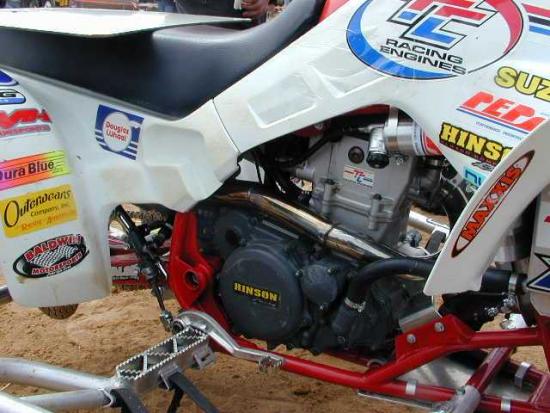Affordable Racing – Revisited
- Updated: January 1, 2006

By George Wolf of Generation X ATV

Believe it or not, back in 1986 pro racers raced with nearly stock set ups. This picture proves just that. Here Marty Hart leads Gary Denton, Don Turk, Jimmy White and Rodney Gentry in lap one of the Pontiac, MI Mickey Thompson Series.
Ever have one of those nightmares where you just can’t move? Since the late 80s, when I got involved, that’s what this sport felt like to me. Every year it seemed to get less thankful, more depressing and more expensive. Magazines showed the same old crap on their covers with deceiving headlines like “New Honda 650 Sport Quad?”, I remember racing to the article inside the magazine only to find out it was just another homemade project and not something soon-to-be offered from the factories. Not that I blame the mags, they were just trying to keep their business alive. When they started their publications, the factories had fresh new machines for them to write about. Then some models vanished and others stayed exactly the same year after year, some of us know those same old boring models as “BNGs” or “Bold New Graphics”. You know, same ole quad, new bold decals.
While all this was going on, the racing side of the sport was trying to keep its head above water. In ’86 the Honda TRX250R was introduced, but just when you thought the sport would really take off with more factory involvement it turned for the worse with zero factory involvement. Basically they pulled out and left us hanging. The mighty 250R pretty much took over even though there were no longer any factory supported riders hired to ride it. And as time went on, if you were not riding a 250R based machine in the 90’s you weren’t a very competitive ATV racer.

Expensive? We know first hand, this ATV Scene project featured an Aren’s R-based geometry frame with a YZ 426 bike motor. ATV Scene’s George Davis pictured.

In the 90’s if you didn’t have a 250R based race quad like Tim Farr’s high-dollar Laeger 250R, you weren’t very competitive.
Gary Denton to the rescue
Legendary Gary Denton paved the way for future ATV racers in the 90’s. Along the way he won eight GNC Championships. If you don’t know his name, learn it and respect it just like bike riders do for Malcom Smith, Roger DeCoster, Jeremy McGrath among others.
If I had to give credit to any one person for helping the sport during this time it would have to be Gary Denton. A lot of you younger riders or people just entering the sport, may not be as familiar with him as some of us older guys or “experienced veterans” as I like to refer to myself as. I raced the Loretta Lynn’s GNC for the first time in ‘92. This was back when the MX and TT series were combined and you had to race both to win the overall championship.
Gary had a professional looking team, pulled crazy holeshots in every moto and had every rider there trying to catch him. He won the championship eight years in a row and I think this gave a lot of pros the determination to de-throne him. In other words, I think he was the spark that the sport needed to continue to survive.

Doug Gust’s one-of-a-kind top-dollar R-based Suzuki DRZ powered quad got the attention of American Suzuki. This added to their inspiration to build their Z400 and later sign Gust and Farr to race it in the 2003 Pro Production class.

Kory Ellis was the first to put the 2002 Cannondale Moto 440 to the test at the Pro Quad Stadium Series that year. Cannondale quickly caught the eye of many in the sport, and surely inspired other manufacturers to release made-for-racing ATVs of their own a few years later.
“Richy Rich” almost ruins everything
I think it was around ‘95 or ‘96 when Honda discontinued selling stock 250R replacement frames. I know this because that’s when I tried to order one to replace mine, which had been welded and gusseted about nine thousand times. By this time, Gary Denton and most of the pros were already on pricey aftermarket frames. Along with the frame came shocks and suspension components, – most of which would not work on your original frame. So if you wanted what the pros were running, you had to buy the whole deal. On the average, a frame with all the extras started at around five grand, but don’t forget that if you didn’t have a good stock machine to start with, you would need to spend plenty extra on all the hardware needed for your garage project. So if you wanted to race the A class and had desires of going pro someday, it was pretty much mandatory to spend some serious money to get to that level.
That’s all fine for the upper classes, but here’s where the near disaster happened. In the beginner class, “Richy Rich” started to show up. You know Richy, he’s the dude whose dad owns every McDonald’s in North Dakota and has an unlimited amount of cash flow. You know the one, he had two of these pro level machines plus an identical practice quad and more extra parts in his 40 foot trailer than the local Honda dealer keeps in stock. Of course he totally dominated the C class, and even lapped most of the competition. This is where the problems began if you ask me. I’m sure that, on more than one occasion, situations like that sent home a first time racer and discouraged him from ever returning to a race track with his stock quad. Did this affect “Richy Rich”? No way! He got his trophy and looked forward to the next event. Did it hurt our sport? I think so.

This was the quad that started the four stroke craze off way back in ’99. It’s Kory Ellis’ Laeger/Yamaha YZ400F. In its very first time on the track, Ellis earned fast qualifier at the St Louis Pro Quad Stadium event and in the process, this quad got the attention of many pro and amateur riders alike – many switched to similar four stroke conversions soon after.
Cannondale’s “Sacrifice Fly”
When I wrote ATV Scene with my first guest column on this topic in Oct of 2001, I got plenty of feedback, some good, and some bad. Many people in this sport are in it for themselves. When the production classes were introduced in 2002 and 2003 many racers turned up their noses at this idea, most of the riders that disagreed with the new production-based racing rules were the riders that were in it for themselves only. Not all of them though, some were just mad that they had already dropped the cash to build a twelve thousand dollar hybrid and, understandably, didn’t want it to go to waste.
Before the production classes came along, the pro class, as well as just about any other class, had starting gates filled with high dollar machines, crazy suspension, big bore 250R engines and dirt-bike-motor hybrid-machines. It was crazy, a twenty thousand dollar quad was quite the norm, in fact as time went on, it became strange to see a 250R with a stock frame. It was tough to persuade these riders to take a few small steps back (to production machines) in order for the sport to jump forward. In ‘98 when the 400EX was introduced it filled many starting gates but depending on the class, it was usually some guy on a fully modified garage project with R-geometry that still came in first. The 400EX was a great quad and introduced ATVs to many, but was not up to par for serious racers.

Kory Ellis made history yet again when he debuted Yamaha’s mighty ’04 YFZ in 2003. This very quad changed ATV racing drastically and is greatly responsible for the sport’s current state and exciting future.
I think the first big step in the right direction came from a bicycle company, believe it or not. Yep, it was Cannondale who introduces what the sport badly needed. Short lived as their incredible efforts were, I think they helped the cause greatly. In my opinion their involvement would be best described in baseball terms as a “sacrifice fly”. Just when Cannondale ATVs started to show up at the Nationals the company went belly-up and they faded away just as fast as they arrived. But with their sac-fly, I think other OEMs, especially the big-four, saw that the public would indeed buy a made-for-racing sport quad, and gave the whole concept of getting involved in ATV racing another look.
Yamaha Revolutionizes ATV Racing
In 2004, only one year after the pro production class was started; Yamaha introduced the ATV that revolutionized the sport as far as I’m concerned. It was their YFZ450 and it was indeed all that! Kory Ellis demonstrated this at the track and introduced what a sport quad was capable of. Soon after Honda and Suzuki entered the ATV scene with true factory support, and the future of ATV racing looked prosperous again. Many were still afraid of stepping backwards to “stock machines” but look where we are now! Yamaha just made something like 80 changes on this year’s YFZ and Honda’s 450R made some great improvements as well. Compare these changes to what the Banshee saw over the last 15 years and that says a lot. And recently Suzuki announced their “all in” approach with their new QuadRacer LTR450, the closest thing to “MX race ready ATV” ever. The average motocrosser guy can buy this, put nerf bars, a kill switch and numbers on it and actually be competitive. I have to believe Kawasaki isn’t far behind as well. Wow, the sport has really progressed in the last few years, hasn’t it?
I think there is no denying the fact that the production class opened the doors to a bigger, better and more affordable sport. And because of it ATV racing is now recognizable to the public. And since the factories are now competing with each other in an effort to produce better machines, the future looks better than ever for all of us! With all these great new machines and the factory involvement to go along with them, the pros will start to see the sport as a lucrative career. In addition, the races will get more TV coverage including full race coverage, not just highlights and wrap-ups, and this will help sponsorships and the whole ATV scene tremendously.

The Pro Production class in 2003 made for a great example for many ATV classes to follow, which they indeed did. Here, factory Suzuki mounted Doug Gust and Tim Farr lead Kory Ellis on another Z400 and Jason Dunkelburger on a Cannondale Moto 440.

Soon Suzuki will release this, the 2006 QuadRacer LTR450. In stock form, it’s said to be the most competitive ATV ever made.
So is it cheaper to race quads now?
Here’s the big question. So is it inexpensive to race now days? No, it will never be cheap; “Richy Rich” will still be out there trying to dominate the beginner class with a better quad than the stocker next to him in the gate. But I do think it’s cheaper now days and that’s a big step in the right direction. Some (including myself) think the production classes or at least the beginner classes should have a few more modification limits, I have even heard Doug Gust mention this on more than one occasion. These limitations just force the factories to produce better stock machines in order to win races. On that point some people argue it would hurt the aftermarket companies that pretty much kept the sport alive in the down times. One frame builder told me he still sells frames and complete hybrid machines all the time. Another told me he makes enough money without the frames and would rather not make them anyway. My company (Generation X ATV) sells Carbon Fiber products and dual steering stabilizers among other things. At the rate stock machines are increasing performance right now it won’t be long before the made-for-racing quads come stock with steering stabilizers. If (or when) that happens, aftermarket companies will just have to rethink things and adapt a little. The smart company will survive. Look at the dirt bike world for an example of our future, I think you’ll agree, there is no shortage of aftermarket goodies over there.
Then, now and the immediate future
In 2001 I, and others, suggested a production class might help, I think it did. With the ‘06 season just around the corner maybe we should think about some better guidelines for the beginner classes in ‘07. Maybe a 400cc class, there is plenty of riders out there with 400s but those guys don’t want to race against the 450s. Regardless, the sport is thriving and I for one am thrilled for that!
That’s my opinion, what’s yours?



